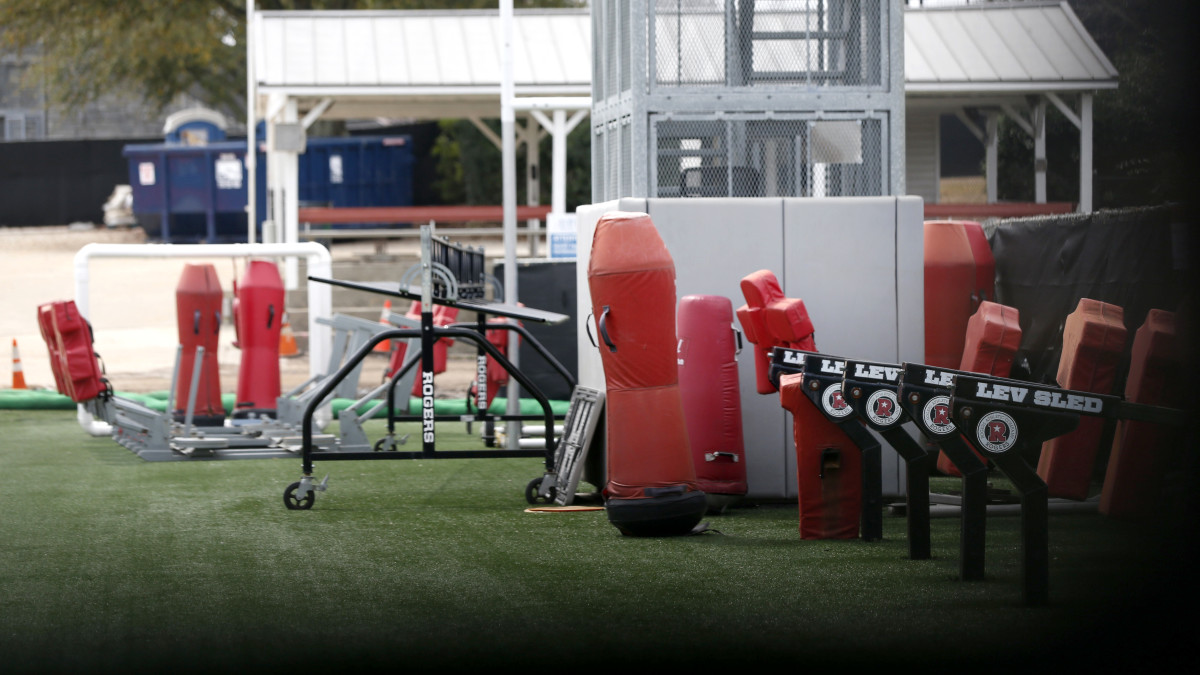College Football Coaches Forced to Go 'Old School' With Summer Training
Larry Kehres won 332 football games, claimed 11 Division III national championships, collected nine coach of the year awards and holds the highest winning percentage in college football history. And he did it all without spring practice and summer training. In fact, some summers, Kehres, now 70 and retired as coach of Mount Union, didn’t do much football at all. “Coached little league baseball,” he laughs. “Summers were different.”
This summer might not be so different. Accustomed to having their players on campus for June and July, Division I coaches might not see them until August. That’s not the half of it. Before the coronavirus pandemic shuttered the sports world, most of them didn’t reach the halfway point in spring practice and some never even started drills. As campus closures extend through summer, a date to begin organized football activities grows hazier. Many coaches have gone four weeks without seeing their players, an absence that could stretch to at least three months by the end of the outbreak. Teaching is relegated to videos, meetings are electronic and training is at the discretion of the player.
“I go back to 25 years ago when it was not the norm for the players to be on campus during the summer,” says South Florida coach Jeff Scott. “Everybody went home after spring and came back for camp. You had a month of practices. We might find ourselves in that situation again.”

Coaches are bracing to squeeze months of on-field, in-person work into a six-week period that might begin sometime in July or, worst case, a four-week camp in August—the busiest, most chaotic camp you’ve ever seen. Well, maybe not ever. For 27 years, Kehres did it as head coach at D-III Mount Union. And don’t call his chaotic—they weren’t. “Everything was planned very precisely,” says Kehres, now athletic director at Mount Union.
For the FBS level, the impacts of an abridged football offseason are wide-ranging. Freshmen lose their normal full summer to orient themselves. Dense playbooks get simplified. And players’ physical condition is adversely impacted. “We’re doing a lot of things that bring us back to the days where we had to rely on our players to be self-motivated,” says Notre Dame coach Brian Kelly, who spent more than 15 years at Division II Grand Valley State. “We’re giving them guidance but, we can’t be mandating workouts and have to trust we have good leadership. We’re giving them the opportunity to consult with us. At Grand Valley, we had to call and check in and if they had questions, they could (ask). We’re seeing a lot of that right now. No doubt, this is a bit old school."
Just in the last 25 years it has become normal for the majority of an FBS team to remain on campus during the summer for academic classes and football activities (you can’t have the latter without the former). For years, only strength coaches could work with players in the summer until the NCAA passed legislation in 2014 allowing on-field coaches two hours a week. Since then, summer training has evolved into a critical time when many athletes realize their most growth. Their physique is sculpted through strength and conditioning programs, and their mind is expanded during classroom-style meetings with position coaches.
At the lower levels of NCAA football, summer training is a truncated version of its FBS self. At D-III, it does not exist at all. In fact, before 2005, coaches in D-III weren’t allowed to hold spring practice. Now, they can hold 15 practices with extreme limitations: no pads, no contact, no equipment at all. That’s better than nothing. For the first two decades of Kehres’s tenure at Mount Union, he’d go more than five months without organized team activities, and in later years, his players like Jason Candle wouldn’t see their coach from the end of the spring semester to reporting day for fall camp—roughly three months. “We had a bunch of guys that played spring sports,” says Candle, a Mount Union receiver in 2000–01. “Couple guys ran track and played baseball. It was workouts on your own.”
Candle, now coach at Toledo, oversees a program with no true offseason. In major college football, it does not exist—until now. And maybe it’s not such a bad thing, says Scot Woolf, quarterback at Mount Union in 1984–85. “It’s like all you do is see your teammates, which is O.K., but after a while, it’s like, ‘Damn,’” says Woolf, who lived the around-the-year football life at Ohio State before transferring in 1983. “Having a little break, I gained a lot.”
The pandemic is turning back the clock to days of a true football offseason, but we’re not sure how much. No one exactly knows when a return to campus activities will happen. It likely depends on a number of factors tied to coronavirus recovery efforts: the lifting of independent state gathering orders, a more widespread rapid test and, potentially, a vaccine. In fact, Carlos Del Rio, an executive associate dean at Emory University media school, delivered a grim message in an interview the NCAA itself posted Saturday on social media. “I hate to say it but for this calendar year, we may never return to normal without a vaccine or some strategies in place,” he said.
Some coaches are targeting early to mid-July as a return date to campus. That seems to be the best possible scenario, but still one that leaves coaches without their players for nearly four months. Several head coaches in FBS have experienced such an offseason schedule. “I’m used to that,” says Will Healy, the coach at Charlotte. The 35-year-old has spent most of his career at the FCS level, where athletic budgets are too tight for teams to have full summer training. “I’m not used to having them May 18 to August,” continues Healy, who landed the Charlotte job in 2019 after three years at FCS Austin Peay. “I interviewed for the job and said ‘How do you fund summer school?’ And they’re like ‘Everybody goes.’ I’m like, ‘What?’”
Many FCS and Division II programs do not supply scholarship aid for summer school, and D-III programs don’t give scholarships at all. Most players at these levels return home during the summer to work jobs while working out on their own. A small group might stay near campus if they’re able to land a job in town. A quarterback at FCS Richmond, Healy recalls his teammates sleeping on inflatable mattresses in the team’s locker room because they couldn’t afford summer housing. He himself slept on an inflatable mattress wedged between a window and kitchen table of a friend’s home. “I don’t like the idea from coaches, ‘Man, if we don't have them back by July 1, I don’t think we can get them ready,’” Healy says. “Well, in FCS, you had to.”
Same goes for D-II. Just in the last six years, strength coaches in D-II have been allowed time to work with athletes over the summer, but because of scholarship restrictions, many don’t stick around, says Jim Collins, who has worked at all four levels of NCAA football—FBS, FCS, D-II and D-III. As coach at D-II Saginaw Valley State, he estimates about one-third of his team remained on campus during the summer. The others received workout plans to do at home, just like Collins got during his days as a D-III player. “We’d have guys show up in August and hope they had done that stuff on their own,” says Collins, now the offensive coordinator at FCS Dayton. “The one thing we did, you had some type of testing that first day back in August—bench press, mile run—to make sure guys understand there is an incentive to do the work over the summer.”
Many coaches at the FBS level are concerned about their players keeping to regimented strength and nutrition programs. For players less fortunate, home life may prevent them from doing each consistently—or at all. In fact, some football staff members were hoping their conference or university would allow some players to remain on campus under their care. “We have kids below the poverty line. We sent some of them back to unhealthy situations,” says one SEC assistant who wished to remain anonymous. “Got some kids homeless. What the f--- are we doing? We have the access to help these guys. The safest place for those kids is on campus.”
Kehres remembers players returning out of shape and failing conditioning tests. He also recalls players showing up carrying 10–15 pounds of extra muscle, looking fit and trim and ready to run through a wall. And then there was that one time his projected starting quarterback arrived to camp. “He looked like he played tennis all summer. He didn't follow the throwing program,” Kehres says. “My experience was, the key players were ready for fall practice. If you weren’t, you stood out. Everybody could tell you had a bad summer.” The physical condition of players might determine a key question: How much time does a football team need to be ready for the season? Those in the industry say anywhere from 30–60 days. “If you got a bunch of guys that are sitting around doing nothing, eating Twinkies every day and watching Netflix, well, it'd probably take longer,” says Clemson coach Dabo Swinney.
At Tulane, Willie Fritz’s worry is about the mental side. Because he’s losing as much as three months with players, he’s ordered his assistants to begin simplifying the playbook, specifically its language. Fritz has coached at three levels of football, including junior college, FCS and FBS. At Sam Houston State, his teams played for two national championships despite only about half of his team staying on campus for player-led summer workouts. On-field coaches, he says, weren’t even allowed to venture into the weight room to monitor players. “If that’s the worst case and you come in and have 29 days before the first game,” he says, “you’re going to get your team together and do it.”
If that worst-case scenario unfolds, freshman playing time may be the biggest impact, coaches say. First-year players normally have the entire summer to acclimate to college life, settling in to the intense juggle of school work, strength training, conditioning drills and football classes. It’s a time to orient with teammates and coaches, too. “If you’re counting on freshmen to show up in fall, that’s where this will show up the most,” Healy says. “Might take them to Week 3 or 4 to be who you thought they would be.”
Over the last few weeks, Kehres has spoken to several of his former players who now coach at the FBS level. He has reminded each of the fall camps at Mount Union, when he readied a team in less than four weeks using three key principles. He treated camp installations as if he were teaching a class: (1) preview the lesson, (2) teach the lesson and (3) review the lesson. Despite FBS coaches missing three to four months of player work, it can all be done during camp, he says. “The key is,” Kehres notes, “use those days better than everybody else.”
